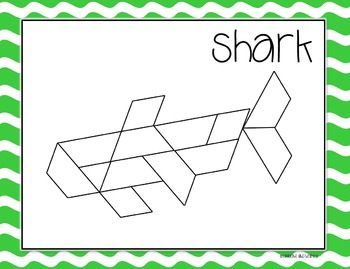Pattern Block Math {Ocean Animal Edition}
Crayons and Whimsy
1.8k Followers
Resource Type
Standards
CCSSK.G.A.2
CCSSK.G.A.3
CCSSK.G.B.6
CCSS1.G.A.2
CCSS1.G.A.3
Formats Included
- PDF
Pages
53 pages
Crayons and Whimsy
1.8k Followers
What educators are saying
Great sheets for early finishers to use in math! My students loved making all of the creatures on the task cards.
Great for my K-2 class. It allows all students to be successful. I use this the first day of school. Studnets work on it as they enter the room. It's easy and fun, and allows me to get other first-day things done with the busy morning!
Description
Using pattern blocks in the classroom is a good way to foster spacial skills and critical thinking. Plus, you will be covering several of the Common Core Math Standards for kindergarten and first grade {K.G.A.2, K.G.A.3, K.G.B.6, 1.G.A.2, 1.G.A.3}
This set comes with 10 different ocean animals at four levels of difficulty. Click the green "Look Inside" button above for more information. You print out the set that fits your class, laminate them and they are ready to use year after year. There are also 3 recording sheets, a pattern block poster and tips for the teacher.
Animals included are:
-crab
-fish
-hermit crab
-jellyfish
-lobster
-octopus
-seahorse
-shark
-turtle
-whale
Actual pattern block pieces are not included.
This set is also included in this bundle:
Pattern Block Math Animal BUNDLE
I also have another bundle of four different Pattern Block sets you can check out:
Seasons of the School Year Pattern Block Bundle
Thank you for stopping by. Check out my blog Crayons and Whimsy for more teaching fun!
This set comes with 10 different ocean animals at four levels of difficulty. Click the green "Look Inside" button above for more information. You print out the set that fits your class, laminate them and they are ready to use year after year. There are also 3 recording sheets, a pattern block poster and tips for the teacher.
Animals included are:
-crab
-fish
-hermit crab
-jellyfish
-lobster
-octopus
-seahorse
-shark
-turtle
-whale
Actual pattern block pieces are not included.
This set is also included in this bundle:
Pattern Block Math Animal BUNDLE
I also have another bundle of four different Pattern Block sets you can check out:
Seasons of the School Year Pattern Block Bundle
Thank you for stopping by. Check out my blog Crayons and Whimsy for more teaching fun!
Total Pages
53 pages
Answer Key
N/A
Teaching Duration
N/A
Report this resource to TPT
Reported resources will be reviewed by our team. Report this resource to let us know if this resource violates TPT’s content guidelines.
Standards
to see state-specific standards (only available in the US).
CCSSK.G.A.2
Correctly name shapes regardless of their orientations or overall size.
CCSSK.G.A.3
Identify shapes as two-dimensional (lying in a plane, “flat”) or three-dimensional (“solid”).
CCSSK.G.B.6
Compose simple shapes to form larger shapes. For example, “Can you join these two triangles with full sides touching to make a rectangle?”
CCSS1.G.A.2
Compose two-dimensional shapes (rectangles, squares, trapezoids, triangles, half-circles, and quarter-circles) or three-dimensional shapes (cubes, right rectangular prisms, right circular cones, and right circular cylinders) to create a composite shape, and compose new shapes from the composite shape.
CCSS1.G.A.3
Partition circles and rectangles into two and four equal shares, describe the shares using the words halves, fourths, and quarters, and use the phrases half of, fourth of, and quarter of. Describe the whole as two of, or four of the shares. Understand for these examples that decomposing into more equal shares creates smaller shares.





